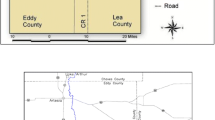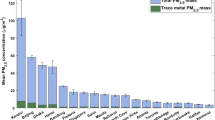Abstract
Lead-210 (210Pb) deposited from the atmosphere is used in the dating of certain geological materials such as glacial ice and lacustrine sediments, but its long-term atmospheric behavior has been little studied. The present investigation reports measurements of airborne 210Pb at 21 monitoring stations in Springfield, Missouri, during 1975–1995. Seasonal and diurnal patterns of atmospheric concentrations are established, and the mean annual concentrations of 210Pb in ground level air during the 20-year period are examined. Although airborne 210Pb concentrations are found to vary diurnally and seasonally, mean annual concentrations in southwest Missouri have remained relatively constant during this time period. This finding is important for geochronological methods that assume a constant 210Pb flux from the atmosphere.
Similar content being viewed by others
Author information
Authors and Affiliations
Additional information
Received: 8 September 1998 · Accepted: 12 October 1998
Rights and permissions
About this article
Cite this article
Sheets, R., Lawrence, A. Temporal dynamics of airborne lead-210 in Missouri (USA): implications for geochronological methods. Environmental Geology 38, 343–348 (1999). https://doi.org/10.1007/s002540050431
Issue Date:
DOI: https://doi.org/10.1007/s002540050431




